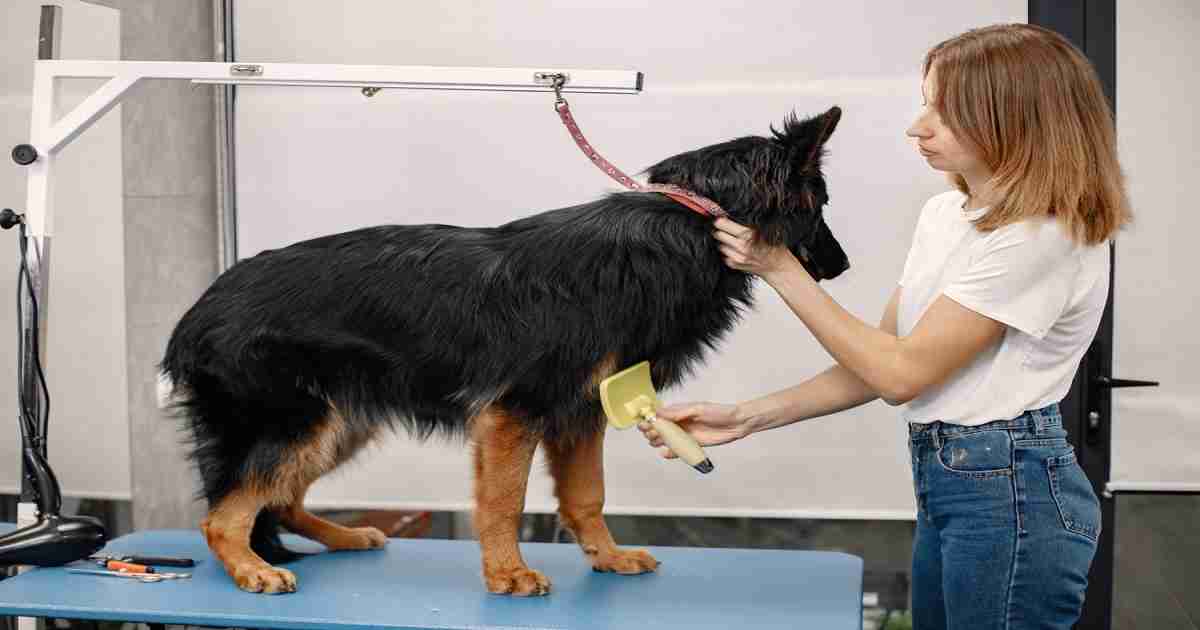Have you ever noticed that your Rottweiler follow like glued to your side, trailing after you from room to room like a furry shadow? Believe it or not, you’re not alone. Rottweilers have earned a reputation as “velcro dogs” for exhibiting this clingy behavior.
But why does your Rottie insist on sticking to you like glue? And is there any way to encourage a little more independence in this devoted breed? Grab some treats and let’s get to the bottom of this velcro dog dilemma!
The Rottweiler Velcro Dog Phenomenon
First things first – what’s behind this whole “velcro dog” label anyway? Well, some breeds like Rottweilers are so loyal and bonded to their owners that their behaviors resemble, you guessed it…velcro!
These dogs just refuse to leave your side for even a second. If you get up, they get up. When you move, they move. It’s like you always have a fluffy canine sidekick glued to your hip!
While extreme velcro tendencies can have some downsides, it all stems from a good place – the Rottweiler’s unwavering devotion. Let’s explore the common reasons behind this sticky behavior:
Strong Loyalty and Bonding
Rottweilers were originally bred to work closely alongside their handlers, so a strong human bond comes built right in. No surprise your Rottie wants to shower you with affection 24/7!
Following allows them to maintain physical closeness and get their fill of pats, praise and belly rubs. For velcro Rotties, sticking by your side = puppy love!
Desire to Protect
Remember, Rottweilers descend from Roman drover dogs who protected livestock ferociously. Those guardian instincts still run strong today.
Your Rottie feels compelled to watch over and protect you (their “flock”). Shadowing your every move allows them to keep you safe from harm. Aw, who needs a bodyguard when you have such a loyal pooch?
Separation Anxiety
Rottweilers are prone to separation anxiety when left alone. A case of the panicked “zoomies” as you head out the door is common.
Sticking to you like glue helps ease separation fears. It provides reassurance that you’re still present and prevents those feelings of isolation Rotties dread.
Herding Instincts
Some velcro dog tendencies stem from innate herding behaviors. Rottweilers were also utilized to herd cattle on farms way back when.
These herding roots mean your Rottie will instinctively try to control and “herd” the movement of their human. Following you closely is just them doing their job!
As you can see, this extreme devotion has deep roots in the Rottweiler breed’s past. While velcro tendencies can become problematic if left unchecked, try to see it as your doggo showing their unconditional love.
Tips to Encourage Independence in Your Rottweiler
Now just because Rottweilers have clung to their velcro dog reputation doesn’t mean you can’t encourage some solo time. Check out these tips:
Obedience Training
Enrolling your Rottie in obedience classes allows them to learn key commands that encourage independence. Work on “stay,” “place,” and “go to your bed” for alone time.
Training also helps establish you as the calm, trusted pack leader. This takes pressure off your Rottweiler feeling they must stick to you.
Prevent Rewarding Velcro Behavior
It’s easy to reinforce clinginess without realizing it. If your Rottweiler gets treats and affection every time they follow you, the behavior is rewarded.
Instead, give treats and praise only when they choose to settle calmly on their own. This shows that independence earns rewards.
Provide Plenty of Mental Stimulation
A bored Rottweiler is more likely to fixate on shadowing you. Prevent this by providing puzzle toys, chews, lick mats, snuffle mats, and food puzzles to stimulate their mind when alone.
This mental tiredness leads to more relaxation and less frantic following. Try freezing a Kong with their kibble to keep them happily occupied.
Maintain Regular Exercise
Velcro dogs are often under-exercised. A tired Rottweiler is a well-behaved Rottweiler! Aim for at least 30-60 minutes of vigorous exercise daily. This could include jogging, swimming, fetching, or hiking.
A calmer, exercised dog will be less “clingy” and anxious when you step away. Prioritize a long walk before any time apart.
Crate Train Your Rottweiler
Crate training not only provides a safe space for your Rottweiler when alone, but helps them learn to be comfortable by themselves.
Make it positive by adding cozy blankets and safe chew toys. Start slow with short sessions, working up to a few hours alone in their crate without stress.
Consult an Expert if Needed
If your Rottweiler exhibits signs of extreme separation anxiety like pacing, destruction, orelimination issues when you leave, consult your vet. They may prescribe medication or recommend seeing a certified trainer or behaviorist for customized training tips.
Why Do Rottweiler Puppies Follow You Everywhere?
Have a Rottweiler puppy glued to your heels? Their clinginess may be for different reasons than an adult Rottie. Here’s why your pup sticks like glue:
Protection: Rottie pups feel safest near their “protector” while young. Sticking close keeps them safe from unfamiliar sights and sounds.
Reassurance: Everything is new and scary for puppies! Following provides comfort and reassurance in this big, overwhelming world.
Socialization: Puppies need positive exposures during the prime socialization window. Shadowing you allows them to experience new things under your guidance.
Attention: Rottie pups crave your love, praise, and attention. Following earns them all the playtime, treats, and cuddles their little heart desires!
If your Rottweiler puppy follows you to a healthy degree, letting them trail along and explore is beneficial. But watch for signs they need to build independence like whining when you step away or inability to self-settle. Doing so sets them up for confidence.
Why Proper Training is Key for Rottweilers
Giving your Rottweiler, both puppy and adult, the gift of training provides immense benefits beyond curbing velcro dog tendencies. Here’s why it’s so critical for this breed:
Establishes Leadership: Rottweilers thrive when there’s a clear pack leader directing them. Training helps reinforce you as their trusted leader.
Teaches Good Behaviors: Training allows you to shape good manners and nip problematic behaviors like jumping or nipping fast.
Provides Mental Stimulation: Rotties need to use their brilliant brains! Training gives their minds a vigorous workout.
Builds Confidence: Mastering new skills through positive training builds self-assurance and independence.
reinforces Bonding: Training strengthens the mutual trust and respect between you and your Rottweiler.
Whether working one-on-one with a professional trainer or attending group classes, training check-ins throughout your Rottweiler’s life will do wonders. An educated Rottie is a happy, well-adjusted Rottie!
Is it bad if my Rottweiler follows me everywhere?
Some velcro tendencies are normal for devoted Rottweilers. But extreme following due to untreated separation anxiety can be detrimental. Consult a vet or trainer if your Rottie exhibits destructive behaviors when you leave.
How can I get my Rottweiler to stop following me?
Use positive reinforcement to reward calm, independent behavior. Provide interactive toys for alone time and use commands like “place” or “crate”. More exercise, training, and mental stimulation also curb following.
What are the velcro dog breeds?
Rottweilers, Labrador Retrievers, Golden Retrievers, German Shepherds, and Bulldogs are often considered “velcro dogs” due to their affectionate, loyal natures and dislike of being left alone.
At what age do Rottweilers calm down?
Rottweilers mature around 2-3 years old. Adolescence brings new training challenges. Stick with consistent training and ample exercise to help your Rottweiler settle into calmer adulthood.
Is My Rottweiler’s Velcro Behavior Totally Normal?
At this point, you’re probably wondering – just how clingy is too clingy when it comes to my Rottweiler? Here are some signs that their following has crossed into problematic territory:
- Destructive behavior when you step away, like digging, chewing, or barking
- Pacing anxiously by doors or windows when you’re gone
- Loss of appetite or refusal to eat without you present
- Depression or lethargy when separated from you
- Elimination “accidents” when left alone, despite being housebroken
- Aggression towards others approaching or interacting with you
If your Rottweiler exhibits separation anxiety to this extreme, it’s time to reach out to your vet about anti-anxiety medication and a trainer to work on independence training.
Left untreated, separation anxiety can impact your dog’s quality of life and lead to safety risks. But the good news is dedicated training and counterconditioning can help significantly.
While some velcro tendencies are just your Rottie showing their endless devotion, anxieties often stem from lack of proper leadership and training. Remember, you want a happy companion by your side – not a stressed out ball of nerves!
With time, consistency and tons of love, you can help your Rottweiler feel secure enough to handle a little alone time. And be sure to cherish those velcro snuggles – just maybe not ALL day long!
Frequently Asked Questions About Rottweilers Following Their Owners
Still have some lingering questions about your Rottweiler’s tendency to mimic your every move? Here are answers to some common velcro dog FAQs:
Why does my Rottweiler puppy follow me everywhere?
Rottweiler puppies follow for reassurance, socialization, safety, and bonding. Sticking close helps them learn about their new world under your guidance. Some shadowing is normal, but make sure to also teach independence.
Why does my Rottweiler follow me and not my partner?
Your Rottweiler likely sees you as their primary caretaker and protector. They feel safest when by your side. Strengthen their bond with your partner by having them help with walks, playtime, and training.
Is a Rottweiler a velcro dog?
Yes, Rottweilers are often considered “velcro dogs” due to their tendency to stick closely by their owner’s side and dislike being left alone. Proper training can help encourage more independence.
How much exercise does a Rottweiler need?
As a large working breed, Rottweilers need substantial exercise – around 30-60 minutes daily. This exercise can help curb velcro tendencies. Prioritize vigorous activities like running, swimming, hiking, and playing fetch.
At what age is a Rottweiler fully grown?
Rottweilers reach their full adult size between 18-24 months, though they mature mentally around age three. Be patient with training – adolescence can bring an increase in clingy or troublesome behaviors.
Why does my Rottweiler sit on me?
Sitting or laying on you allows your Rottie to feel physically close and show affection. If this behavior becomes problematic, train an “off” command and redirect them to a dog bed for cuddles.
Should I crate train my Rottweiler?
Absolutely! Crate training helps a Rottweiler learn to relax when alone, providing a secure den-like space. Just introduce crating gradually with lots of treats and praise. Never use their crate for punishment.
The Velcro Dog Dilemma: Conquering Clinginess With Patience and Training
Well, we’ve reached the end of this deep dive into why Rottweilers often exhibit “velcro” clinginess with their owners. Here’s a quick recap:
- Rottweilers form incredibly strong bonds that fuel their desire to stick by your side.
- Their protective nature also leads to “shadowing” to keep you safe.
- Anxieties like separation anxiety may also trigger following behaviors.
- Certain ingrained traits like herding instincts contribute to their velcro dog tendencies.
While it’s important to discourage extreme dependence, try to have patience. This behavior comes from a place of devotion. With proper training, confidence building, and independence skills, your Rottweiler can learn to be comfortable on their own.
Sure, they may always be your loyal little sidekick eager to share your space. But with compassion and dedication, you can help them strike the perfect balance between together time and solo time.
Thanks for taking the time to learn more about this common Rottweiler behavior. Hopefully you feel empowered to start modifying those velcro habits while still appreciating your dog’s desire to stick by your side.
Just remember – a well-loved Rottweiler will bond securely and show affection without becoming your conjoined twin! Patience and consistency will help you raise both an independent AND devoted companion.
So embrace those sloppy Rottweiler kisses, but also encourage some independent playtime with a puzzle toy or set up a relaxing space just for your pooch. With a balanced approach, you and your Rottie will both get your needs met!









1 thought on “How To Make My Rottweiler Follow You Everywhere”